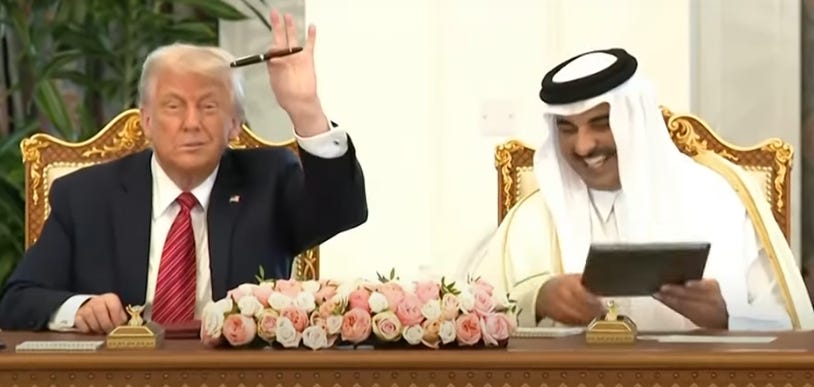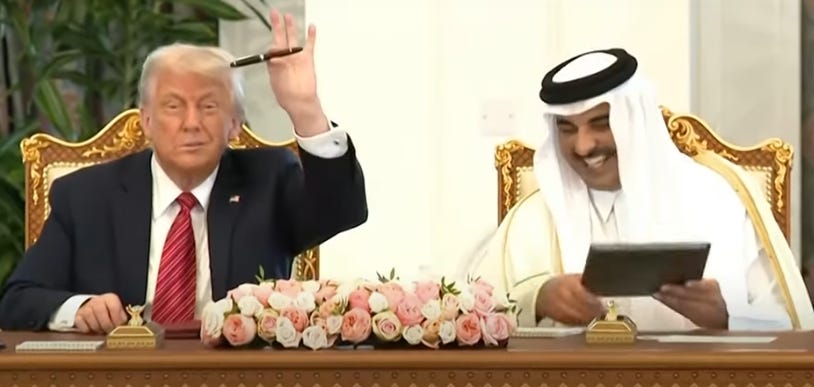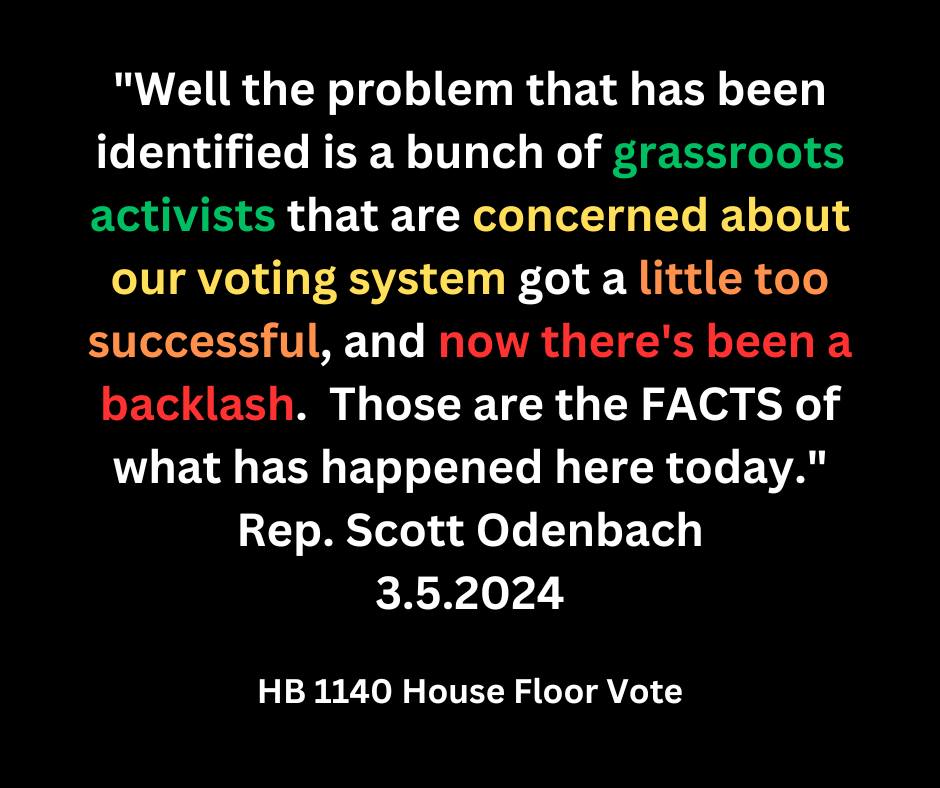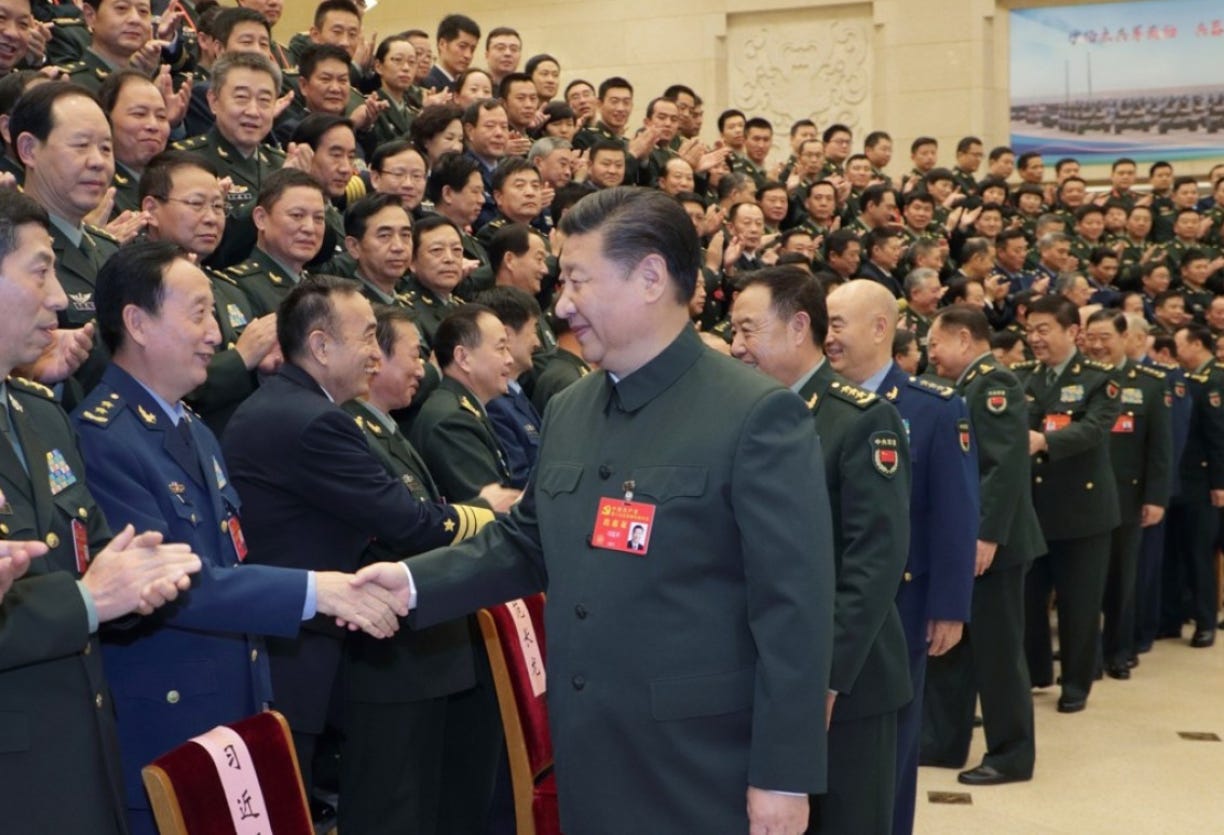
President Donald Trump signed economic and defense agreements Qatar’s ruling emir, Sheikh Tamim Al Thani
President Trump has concluded extremely productive visits to Gulf Cooperation Council states of Saudi Arabia, Qatar, and the United Arab Emirates. The Cooperation Council for the Arab States of the Gulf, also known as the Gulf Cooperation Council, is a regional, intergovernmental, political, and economic union comprising Bahrain, Kuwait, Oman, Qatar, Saudi Arabia, and the United Arab Emirates.
The trip has been panned by the Democrat-media complex as they focus on the Qatari offer of a airplane to the US Defense Dept as a stop-gap until Boeing delivers a new Air Force One at some point in the distant future (see this for the truth about that plane). After all, their relentless narrative is anti-Trump all the time, regardless of the major achievements in just over 100 days of his second administration. Despite the Democrat-media spinning, the reality of that trip is that Trump reset US foreign policy while concluding commercial commitments totaling over $3 trillion with the three countries.
Before detailing the trade agreements, it is extremely important to summarize the most important foreign policy speech by a US president that took place in Saudi Arabia on 13 May in Riyadh (transcript here). Trump used the speech to denounce decades of US interventionist policies, criticizing “nation-building” efforts in Iraq and Afghanistan as failures. He declared that the US would no longer “lecture” Middle Eastern nations on governance, emphasizing regional sovereignty and self-determination. This marked a clear break from the neoconservative policies of past administrations, aligning with an “America First” stance that prioritizes non-interference and transactional diplomacy.
Furthermore, President Trump emphasized commerce over conflict in future dealing with countries around the world, in particular in the Middle East. He articulated a vision for the Middle East defined by “commerce, not chaos,” urging regional leaders to prioritize economic development over conflict. This message resonated with Gulf states like Saudi Arabia, which are diversifying their economies under initiatives like Vision 2030. And the unprecedented receptions he received in all three countries show how his message resonated with them! Check out this Fox News report on his Saudi Arabia visit:
FOREIGN DIRECT INVESTMENTS
In addition to the broad resetting of US foreign policy, President Trump’s visit has resulted in substantial foreign direct investment commitments and related economic/purchase agreements with the three GCC nations.
Foreign Direct Investment (FDI) refers to an investment made in one country into business interests in another country, with the intent of establishing a lasting interest or significant degree of control. Unlike portfolio investments (e.g., stocks or bonds), FDI involves a long-term relationship and substantial influence over the foreign entity’s operations. The two main categories of FDI are county investments and company investments. The latter are frequently multinational corporations.
Here is a list of over $3.5 trillion in FDI commitments made in 2025 by various countries, including the pledges made during the president’s recent Middle East Trip:
- United Arab Emirates: $1.4 trillion over 10 years for investments in AI infrastructure, semiconductors, energy, and manufacturing. The UAE’s investment aligns with the U.S. encouraging allied nations with “tremendous sovereign wealth funds” to invest, per the National Security Presidential Memorandum (NSPM) issued on 21 February.
- Qatar: $1.2 trillion, described as an “economic exchange” over an unspecified period. This figure includes trade deals, investments, and potential future commitments driving innovation, manufacturing, and technological leadership in the US. Specific sectors impacted include AI, energy, defense, and high-tech industries. This includes a landmark deal to purchase up to 210 Boeing 787 Dreamliner and 777X aircraft, powered by GE Aerospace engines. This is the largest-ever order for Boeing’s widebody aircraft and is expected to support an estimated 154,000 US jobs annually.
- Saudi Arabia: $600 billion for investments in the US, highlighted at the 2025 Saudi-U.S. Investment Forum. Announced as part of an overarching economic cooperation agreement, the scope spans energy, technology, and manufacturing sectors and reflects Saudi Arabia’s strategic partnership with the US under Trump’s policies.
- Japan (SoftBank): SoftBank, led by Masayoshi Son, pledged $100 billion, often linked to technology and AI infrastructure, including collaborations like the Stargate AI project. This is separate from Japan’s broader FDI contributions. Note: Japan is the largest single-country investor in the US, with a cumulative FDI position of $810 billion (15% of total FDIUS) through 2023. SoftBank’s pledge aligns with the president’s National Security Presidential Memorandum’s (NSPM) push for accelerated investments in advanced technology.
- Taiwan (TSMC): Taiwan Semiconductor Manufacturing Company (TSMC) announced investments ranging from $100-$165 billion for semiconductor expansion, including new factories in Arizona. These aim to bolster US chip production and reduce a strategic vulnerability in chip manufacturing.
- South Korea (Hyundai): Hyundai pledged $20–$21 billion, likely for automotive manufacturing and electric vehicle production.
The following is a list of over $3.9 trillion in investment commitments made by foreign, multinational, and US-owned companies in 2025:
- Apple: $500 billion for US manufacturing and training, including a new factory in Texas, a manufacturing academy in Detroit, and expansions in Arizona, Nevada, California, North Carolina, and other states. Expected to create 20,000 jobs over four years. Announced post-Trump’s 10% tariff on China.
- Project Stargate (OpenAI, Oracle, SoftBank): $500 billion for AI infrastructure in the US Announced 21 January 21, though development began earlier.
- NVIDIA: $500 billion over four years to build AI supercomputers entirely in the U.S., focusing on AI infrastructure.
- IBM: $150 billion over five years for US-based growth and manufacturing operations.
- Johnson & Johnson: $55 billion over four years for U.S. investments, though $2 billion was announced in October 2024 for a North Carolina facility.
- Eli Lilly: $27 billion for four new manufacturing facilities, expected to create 3,000 jobs and require 10,000 construction workers. Announced post-Trump’s pharmaceutical import tariff threats.
- Hyundai: $21 billion for US investments, likely in automotive manufacturing, though specifics are sparse.
- CMA CGM (France-based): $20 billion for UD shipping and logistics, expected to create 10,000 jobs.
- DAMAC Properties: $20 billion initial investment for new US-based data centers.
- Venture Global LNG: $18 billion for a liquefied natural gas facility in Louisiana.
- Gilead Sciences: $11 billion for US manufacturing and research.
- AbbVie: $10 billion over 10 years to support volume growth and add four new manufacturing plants.
- Merck & Co.: $9 billion for US investments, sectors unspecified.
- Pratt Industries: $5 billion to create 5,000 manufacturing jobs in Ohio, Michigan, Pennsylvania, and Arizona.
- NOVONIX Limited (Australia-based): $4.6 billion for a synthetic graphite manufacturing facility in Tennessee.
- Thermo Fisher Scientific: $2 billion over four years to expand US manufacturing and innovation.
- Corning: $1.5 billion to expand a Michigan solar products facility, creating 1,500 jobs (includes $900 million announced pre-Trump).
- GE Aerospace: $1 billion for manufacturing across 16 states, creating 5,000 jobs.
- Anduril Industries: $1 billion for a new autonomous weapon system facility in Ohio.
- Amgen: $900 million for Ohio-based manufacturing operations.
- Merck Animal Health: $895 million to expand Kansas manufacturing operations.
- Schneider Electric: $700 million over four years for US energy infrastructure.
- GE Vernova: $600 million over two years for US manufacturing, creating 1,500 jobs.
- Abbott Laboratories: $500 million for facilities in Illinois and Texas.
- Cyclic Materials (Canada-based): $20 million for a rare earth elements recycling facility in Mesa, Arizona.
- Guardian Bikes: $19 million for a bicycle frame manufacturing operation in Indiana.
- AMG Critical Minerals (Netherlands-based): $15 million for a chrome manufacturing facility in Pennsylvania.
- LGM Pharma: $6 million to expand a manufacturing facility in Rosenberg, Texas.
- ViDARR: $2.69 million for a defense optical equipment facility in Virginia.
CONCLUDING THOUGHTS
In less than 120 days of his second administration, President Trump has personally been involved in, and/or stimulated by his new economic policies, at least $7.4 trillion in FDI and domestic investment commitments that will boost the US economy greatly in the coming years. And then there are the revenues that will be accumulated as reciprocal tariffs are negotiated with all US trade partners.
The Biden administration record pales in comparison, attracting only an estimated $600–$700 billion in FDI commitments over four years, based on:
- $200 billion from Asia-Pacific economies (2021–2023)
- $227 billion in 2024 greenfield projects (built from scratch)
- $200–$300 billion in additional pledges and inflows not realized. Actual inflows were likely $500–$600 billion (2022–2023: $325.8 billion; 2024 estimated at $150–$200 billion).
The legacy media are silent in comparing the Biden record with what President Trump has accomplished in just three months! This is the reality of America First policies and Making America Great Again – to the benefit of all Americans. The Democrat-media naysayers have nothing to offer other than endless complaints, lawfare, and false ethics charges (just like during President Trump’s first term).
And President Trump is only getting started; imagine how long the country and company investment lists will be in four years!
The end.




